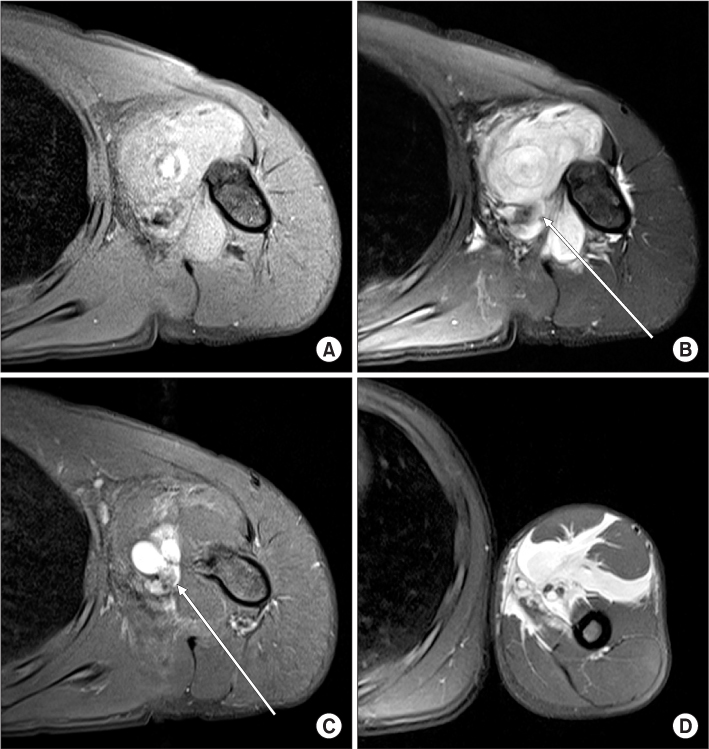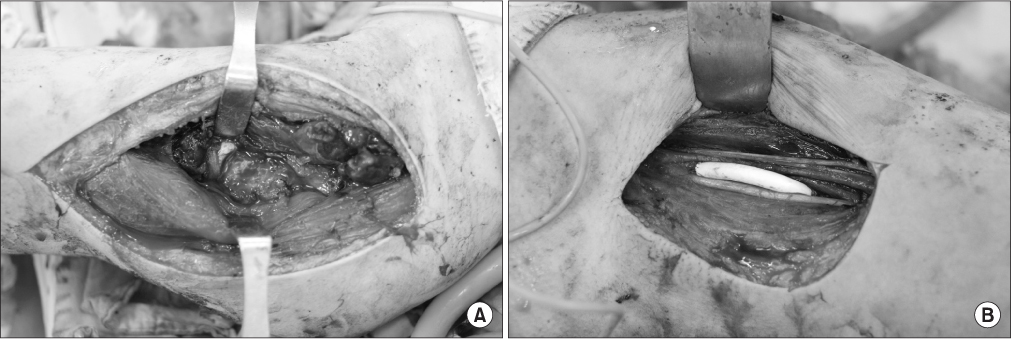J Korean Orthop Assoc.
2013 Aug;48(4):297-301.
Rupture of a Brachial Artery Caused by a Humeral Osteochondroma
- Affiliations
-
- 1Department of Orthopedic Surgery, Korea Cancer Center Hospital, Seoul, Korea. wssongmd@gmail.com
Abstract
- Pseudoaneurysm resulting from vascular impingement by an osteochondroma is extremely rare. The authors report on the case of a 16-year-old male who had a brachial artery pseudoaneurysm and vessel rupture associated with a humeral osteochondroma. This case suggests that pseudoaneurysm should be considered for the differential diagnosis in patients with soft tissue masses and a cuspidal osteochondroma located near the neurovascular bundle and recommends Doppler sonography or angiography.
MeSH Terms
Figure
Reference
-
1. Eschelman DJ, Gardiner GA Jr, Deely DM. Osteochondroma: an unusual cause of vascular disease in young adults. J Vasc Interv Radiol. 1995; 6:605–613.
Article2. Scotti C, Marone EM, Brasca LE, et al. Pseudoaneurysm overlying an osteochondroma: a noteworthy complication. J Orthop Traumatol. 2010; 11:251–255.
Article3. Vasseur MA, Fabre O. Vascular complications of osteochondromas. J Vasc Surg. 2000; 31:532–538.
Article4. Kim YJ, Baek WK, Kim JY, et al. Pseudoaneurysm of the popliteal artery mimicking tumorous condition. J Korean Surg Soc. 2011; 80:Suppl 1. S71–S74.
Article5. Bilotta W, Walker H, McDonald DJ, Sundaram M. Case report 651: thrombosed, leaking popliteal aneurysm. Skeletal Radiol. 1991; 20:71–72.6. Mann HA, Hilton A, Goddard NJ, Smith MA, Holloway B, Lee CA. Synovial sarcoma mimicking haemophilic pseudotumour. Sarcoma. 2006; 2006:27212.
Article7. Hermann G, Abdelwahab IF, Miller TT, Klein MJ, Lewis MM. Tumour and tumour-like conditions of the soft tissue: magnetic resonance imaging features differentiating benign from malignant masses. Br J Radiol. 1992; 65:14–20.
Article8. Tobias AM, Chang B. A rare brachial artery pseudoaneurysm 13 years after excision of a humeral osteochondroma. Ann Plast Surg. 2004; 52:419–422.
Article9. Gerrand CH. False aneurysm and brachial plexus palsy complicating a proximal humeral exostosis. J Hand Surg Br. 1997; 22:413–415.
Article10. Longo JM, Rodríguez-Cabello J, Bilbao JI, Aquerreta JD, Ruza M, Mansilla F. Popliteal vein thrombosis and popliteal artery compression complicating fibular osteochondroma: ultrasound diagnosis. J Clin Ultrasound. 1990; 18:507–509.
Article
- Full Text Links
- Actions
-
Cited
- CITED
-
- Close
- Share
- Similar articles
-
- Treatment of Brachial Artery Injury with Humeral Shaft Fracture Using Endovascular Stenting
- Delayed Brachial Artery Occlusion after Humeral Shaft Open Fracture: A Case Report
- Cubital Tunnel Syndrome Caused by Osteochondroma: A Case Report
- Clinical Study on Angiogram before and after Arteriorrhaphy for Traumatic Vascular Injury of Extremities in 20 cases
- A Morphological Study of the Branches of the Axillary Artery in Korean Female





